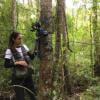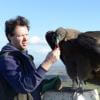With experts across the WILDLABS community working with every type of technology and in every imaginable environment, our platform is a great place to find advice and resources on choosing what tools are right for your conservation project. Whether you're in the market to try a new camera trap model, want to experiment with drones for the first time, or need help weighing the pros and cons of data management tools, there's someone in the WILDLABS community who can help you make a smart and informed choice!
The Community Base is our general gathering group. It's the place where we cover more general, big picture topics in conservation technology - ones that don't fit neatly into our other groups. If you don't know where to post something, just post it in this group. Our moderators will move it if needed!
At our Community Base, you'll find updates from the WILDLABS team on upcoming events and opportunities, and have the chance to shape our programs and platform with your opinions. And most importantly, the Community Base is also home to our Welcome to WILDLABS thread, the best place to introduce yourself to us and the community. Stop by and tell us what you're working on!
Whether you're new to WILDLABS and want to know where to begin, or you're a longtime member looking for a handy bank of resources, our Getting Started on WILDLABS thread will be your one-stop guide to getting the most out of our platform.
Want to find out more about WILDLABS? Check out our recent community call:
Header image: Ana Verahrami/Elephant Listening Project
Group curators
- @TaliaSpeaker
- | She/her
WILDLABS & World Wide Fund for Nature/ World Wildlife Fund (WWF)
I'm the Executive Manager of WILDLABS at WWF



- 23 Resources
- 64 Discussions
- 31 Groups
- @alexrood
- | she/her
WILDLABS & World Wide Fund for Nature/ World Wildlife Fund (WWF)
I'm the WILDLABS Communications and Community Management Associate Specialist at WWF-US





- 149 Resources
- 95 Discussions
- 6 Groups
No showcases have been added to this group yet.
- @matt_hron
- | He/Him
Wildlife Protection Solutions (WPS)
Product Manager at Wildlife Protection Solutions



- 0 Resources
- 8 Discussions
- 8 Groups
BSc Forest Engineering, MSc GIS Sciences, Drone researcher

- 2 Resources
- 11 Discussions
- 5 Groups
Apasionado por la vida en el campo y la electronica aplicada a proyectos de conservacion



- 0 Resources
- 37 Discussions
- 3 Groups
- 0 Resources
- 0 Discussions
- 6 Groups
trying to understand and improve the welfare of all animals that can suffer


- 4 Resources
- 6 Discussions
- 7 Groups
- 0 Resources
- 0 Discussions
- 3 Groups
- @npeoples
- | she/her/hers
Undergraduate student at UNC-Chapel Hill studying environmental science and journalism



- 4 Resources
- 1 Discussions
- 2 Groups
- @amklovrza
- | she / her
Hello! My name is Anabelle Marques Klovrza and I am a Ph.D. student at Dawson's lab. I am studying community assembly of island-like environments, and in trying to connect it with the vulnerability and fragility of the ecosystem.
- 0 Resources
- 0 Discussions
- 8 Groups
I am an environmental enthusiast with great passion for conservation, preservation and protecting the environment and wildlife and the natural resources. With
- 0 Resources
- 0 Discussions
- 3 Groups
University of Salford
- 0 Resources
- 2 Discussions
- 6 Groups
- @HollyCormack
- | she/her
Biodiversity Knowledge Management Intern at the Biodiversity Consultancy Ltd



- 6 Resources
- 5 Discussions
- 6 Groups
- @ryanhuang
- | He/Him/His
Conservation scientist based in Pretoria, South Africa
- 0 Resources
- 0 Discussions
- 6 Groups
We are a team of ecologists and technologists who believe good business must be good for nature. We’re building an economy that puts nature and business in balance by incentivising the restoration of nature at scale.
7 July 2023
Applications are now open till 23 July for the 2023 Canon Oceania Grants with the category of the Environmental Grant valued at AU$5,000. The finalist will be selected based on the environmental and social merits of...
7 July 2023
Join our annual #Tech4Wildlife Photo Challenge from July 24-28 to share your best photos and videos with conservation tech users, makers, and supporters from around the world.
7 July 2023
In this article from Fran Baker, Fiona Riggall, and Ed Miller, you'll learn how tech companies like Arm can incorporate sustainability into their mindset for longterm success.
5 July 2023
Article
Say hello to the WILDLABS community on Instagram and help us highlight conservation tech work happening around the world!
1 July 2023
CBE is recruiting a full-time Senior Wind Engineering Manager to drive the development and implementation of their existing and future wind portfolio.
27 June 2023
The GSMA ClimateTech programme
21 June 2023
In this article from Jacinta Plucinski & Akiba of Freaklabs, they share advice on organising your thoughts around building short-term and long-term sustainability considerations into your conservation technology...
21 June 2023
Careers
Come work with us! WILDLABS and Fauna & Flora are seeking a Project Manager to join our team and help deliver projects under our cross-sector funding and events programmes. Accepting applications until Sunday, 9...
16 June 2023
Come work with us! WILDLABS and Fauna & Flora are seeking an intern to help develop the movement ecology content on the Inventory - our wiki-inspired database of conservation technology. Accepting applications until...
6 June 2023
Inger Andersen, the Executive Director of the UN Environment Programme (UNEP) explains how the innovative approaches towards curbing plastic pollution witnessed across African nations can help in pivoting to a plastics-...
5 June 2023
It's World Environment Day! This year the focus is on solutions to plastic pollution under the campaign #BeatPlasticPollution. How are you getting involved to solve plastic pollution using conservation technology?
5 June 2023
October 2025
event
event
event
November 2025
February 2026
April 2026
event
May 2023
event
April 2023
event
| Description | Activity | Replies | Groups | Updated |
|---|---|---|---|---|
| Hi. I can give a brief blurb on the state of wireless sensor networks if you want. I don't think it will be a very deep dive due to time limitations, but can discuss how we... |
|
Community Base | 4 years ago | |
| Yep Its sill open you can join Slack https://join.slack.com/t/hack4nature/shared_invite/zt-t1rw4ee8-3_nFMzc~4zyyrkT~YucE8w ? |
|
Community Base | 4 years 1 month ago | |
| The Earth Defenders Toolkit is a collaborative space for earth defenders and their allies. The Toolkit provides a growing collection of... |
|
Community Base | 4 years 1 month ago | |
| Celebrating sites with innovative, integrated approaches to protected and conserved area management that successfully conserve nature while... |
|
Community Base | 4 years 1 month ago | |
| Read more: The problem with innovation challenges Project Rattlecam. Read more about Project Rattlecam founder Emily Taylor’s work using conservation tech... |
|
Community Base | 4 years 1 month ago | |
| Great suggestion Ollie, it gave us an excuse to ask NASA to teach a tutorial.. We are so excited about this new season, we'll be sharing the first part of the lineup next... |
|
Community Base | 4 years 1 month ago | |
| Here's one that I thought was interesting. It's unfortunately straight out of a research lab so it's not commercially available, but it would be interesting to see... |
|
Community Base | 4 years 1 month ago | |
| Read more: eDNA sampled from stream networks correlates with camera trap detection rates of terrestrial mammals (2020) https://doi.org/10.1038/s41598-021-90598... |
|
Community Base | 4 years 1 month ago | |
| Hey David, Awesome, that sounds perfect! I'll email you some of the guidelines and a basic outline to get started with next week! Thanks again, excited to have you... |
|
Community Base | 4 years 2 months ago | |
| Read more: The G.AI.A series: Artificial Intelligence and Planetary-Scale Environmental Management, @davethau: https://medium.com/g-ai-a Dave Thau... |
|
Community Base | 4 years 2 months ago | |
| Check out this update for a sneak peek at early results and more info about why this research matters. Do you agree with the trends so far? Let us know on the survey. |
|
Community Base | 4 years 3 months ago | |
| https://www.goodtechfest.com/agenda The Good Tech Fest focuses on nonprofits, philanthropy, and some civil society projects. It's... |
|
Community Base | 4 years 4 months ago |
Social Tech Seed: Applications now open
23 March 2016 3:59pm
What do you do in your spare time?
2 March 2016 11:04am
Indianapolis Prize Finalists announced
9 February 2016 4:31pm
New Groups - what's in development and what would you like?
14 January 2016 3:02pm
New article about WILDLABS.NET: Where Technology and Conservation Meet
24 December 2015 4:33pm
Second Tiger Cub Dies in Crimea Zoo After Blackout
7 December 2015 10:31pm
8 December 2015 12:42pm
Hi, Stephanie
"WILDLABS.NET is a community of conservationists, technologists, engineers, data scientists, entrepreneurs and change makers. Together, we share information, ideas, tools and resources to discover and implement technology-enabled solutions to some of the biggest conservation challenges facing our planet. Join the Community to share your knowledge, explore ongoing projects, ask questions and identify major questions and needs. This community is a centralised space for field based conservationists to connect directly with technology experts, to share their challenges and source new ideas for solutions. Connecting with users on the ground will help technologists and innovators to test ideas in field environments, and adapt systems that can accelerate conservation gains. The problems faced by our planet cannot be solved by people working in silos. Become part of theCommunity and work together to build the solutions." (from WILDLABS.NET front page)
Bengal tigers (especially white ones) are identified as endangered species. Blackouts can happen anywhere.. So, as this is a community based on technological solutions, discussions, and sharing ideas and collaborating, I believed someone could have an idea about what can we, as conservationists, do, in order to prevent such loses of endangered species in the zoos, in the future. I'm less interested in politics when it concerns the lives of innocent animals suffering from imperfect conditions in the zoos etc. Any loss of endangered species, anywhere in the world, is a wildlife crime, because we can not afford to let our children live in the world where there's no elephants, rhinos or bengal tigers etc.
On the contrary, this is exactly what I've been saying, that technological innovations (ideas, projects) are exactly what could we all seriously regard in order to solve such problem that happened to the animals in the Crimean zoo. For example, zoos areas could have better equipment with alternative energy generators, or some innovative energy generators. In case of a blackout for example (man-made, natural, technological), in some country for example, it immediately puts at risk the zoos |and the safety and security of its animals|(and not only, but here we discuss environmental issues), for example if it's a cold country: Finland, Russia, Ukraine, Canada etc, on my opinion, I think it would be better if the zoos be equipped with alternative power generators. So, if anyone in the community, have an idea what kind of innovations could be used for the zoos (all over the world) I would be happy to read.
Thank you,
With love,
Sofia
France24.com video segment on wildlife conservation technology
4 December 2015 7:51pm
7 December 2015 11:55am
Thanks for posting Dave - it's a neat overview of lots of different projects. I hadn't seen the SMART hook before, so worth the watch!
Bengal tiger cub dies of cold at Crimea zoo hit by power cuts.
4 December 2015 6:22pm
Bengal tiger cub dies of cold at Crimea zoo hit by power cuts.
4 December 2015 5:36pm
Rare friendship between a tiger and a goat!
4 December 2015 5:29pm
wildtech.mongabay.com is a great resource
2 December 2015 10:40pm
3 December 2015 2:19pm
Thanks for the link - yes, I agree Mongabay's WildTech areas is a great resource for anyone interested in keeping up to date with the latest conservation tech news. Sue Palminteri's article is facinating and is definitely worth a read. The video showing the daily movement of elephants is particularly interesting (see the screenshot below) - it was a case study Katherine Chou of Google.org spoke about in her Fuller Symposium address as well. That they're getting close to real time monitoring is very exciting - it would have been amazing to have that capacity in other projects I've been involved with.
The key take-aways you highlight match a lot of what came up in the Fuller Symposium and other discussions about HWC. The consensus from Wired in the Wild - Can technology save the planet? was that no, it cannot. It is simply a very useful tool that, when used appropriately, could have significant impacts in the challenges conservation is attempting to tackle. Numerous speakers drove home the point that technology is not and should not be the starting point; we need to be technology agnostic. We must start by understanding the challenge and then looking at what (if any) technology might help to address it given the circumstances.
The Elephants and Bees approach is a great example of why we need to start with challenge rather than the technology. Sometimes the best solution is the low tech approach. Nilanga Jayasinghe highlighed this in her thought piece about HWC - giving a similar example of work WWF is doing in Nepal:
'During a recent visit to Nepal, I visited rural villages where wild elephants often raid rice fields during harvest season. The communities had installed electric fences but this tool didn't always succeed on its own. Elephants are smart and persistent: they had learned to break the fence’s electric current, and then the fence itself, by using trees to push over the supporting stakes. To solve this problem, we worked with farmers to dig fish ponds in front of the fences as an additional obstacle. Adding an additional barrier not only made it harder for the elephants to get into the fields, it also gave the communities more time to respond and drive elephants away. This simple solution has not only reduced elephant raids, but has also improved local livelihoods from the sale of the fish grown in the ponds.'

Frequently Asked Questions
30 October 2015 5:43pm









































8 December 2015 12:11pm
Hi Sofia,
While there is a argument that the death of Bengal Tigers at a zoo in Crimea could potentially be viewed wildlife crime, your original post was unclear about how this was relevant to a professional community that is focused on collaborating and sharing ideas about conservation technology. I would argue that technological innovation might not be the most important element for finding a solution to the problem you have identified. Rather, there are political, social and economic factors that must be addressed as a higher priority, and if addressed effectively, will negate the need for a complex technological solution to this issue.
That being said, I welcome any community member who might be interested to continue the discussion below.
Cheers,
Stephanie